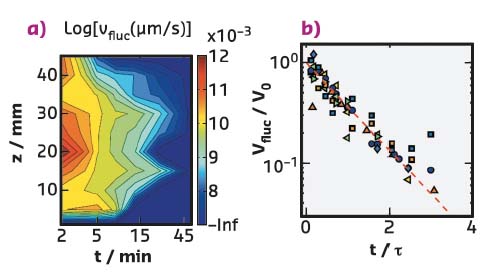- Home
- Users & Science
- Scientific Documentation
- ESRF Highlights
- ESRF Highlights 2017
- Complex systems and biomedical sciences
- Velocity fluctuations during particle sedimentation probed by multispeckle XPCS
Velocity fluctuations during particle sedimentation probed by multispeckle XPCS
Settling of suspensions under the influence of gravity is an everyday experience. It is widely exploited in industrial separation processes as well as involved in geological formations. Ultra-small-angle XPCS provides new insight about the early stage of sedimentation.
Sedimentation at the colloidal scale has been extensively investigated for more than a century [1]. It has been identified as a powerful method for probing the interactions and dynamics in particulate suspensions [2]. A sedimenting suspension is an out-of-equilibrium system and many puzzles in its dynamics remain unresolved [1]. A particular case is when thermally driven Brownian motion is comparable to gravity-induced flow, which corresponds to the Peclet number (Pe) ≈ 1. If there are only a few independent particles in the suspension, their sedimentation velocity is given by the well-known Stokes law. However, in a suspension with finite concentration, the hydrodynamic back flow causes a reduction of the sedimentation velocity (<V>) from the Stokes velocity. Fluctuations in the local particle number density lead to a variance in the sedimentation speed that may diverge up to the smallest container dimension [3].
Nevertheless, the gravity-induced stratification may preclude observation of a divergence of velocity fluctuations [1, 4]. The stratification effects can be delayed by several hours using Brownian particles (Pe < 1). Then it becomes experimentally challenging to separate contributions of gravity-induced advective and thermal diffusive motions. Multispeckle ultra-small-angle X-ray photon correlation spectroscopy (USA-XPCS) was used at beamline ID02 to probe the gradual transition of dynamics in suspensions of charge-stabilised Brownian particles prior to the onset of macroscopic sedimentation front. A key advantage of multispeckle XPCS is that it allows a direction-dependent analysis of the dynamics (e.g., the gravity-induced advective motions along the vertical direction). The ultra-small-angle range provides access to the pertinent length scales.
 |
|
Fig. 62: a) Schematic representation of sedimentation and the scattering geometry used for multispeckle XPCS. b) Typical intensity autocorrelation functions as a function of elapsed time parallel to the sedimentation direction. c) The ratio of vertical and horizontal functions displaying the purely advective contribution and corresponding temporal evolution. |
Figure 62 shows the experimental scheme and typical intensity autocorrelation functions measured along the vertical direction parallel to the sedimentation. The periodic modulation in the autocorrelation function is a signature of the well-defined advective motions that dominate colloid dynamics during early stages of sedimentation. With elapsing time, these periodic modulations become indistinct, corresponding to a decay of advective currents and eventually diffusive motions become the dominating contribution in the dynamics.
Measured XPCS correlation functions can be modelled by taking into account the Doppler shifts caused by all particle pairs in the scattering volume in terms of a relatively simple velocity distribution (Figure 62b). The decay of the XPCS correlation function is particularly sensitive to relative velocity fluctuations and the different scattering vector (q) dependence permits the separation of advective contribution (linear in q) from conventional diffusive part (quadratic in q) as shown in Figure 62c. These velocity fluctuations decay over the first hour of the experiment, then measured correlation functions along vertical and horizontal directions become identical. This corresponds to the velocity fluctuations not only slowing down but also decreasing in their overall extent, i.e. the breakup of flow structures over time. This change of dynamic behaviour occurs on a much shorter timescale (minutes) than the appearance of the macroscopic sedimentation front (several hours). Figure 63a displays the sensitivity of the initial conditions on the decay of velocity fluctuations (Vfluc) along the height of the capillary prior to the onset of macroscopic sedimentation front. Nevertheless, once normalised by the initial Vfluc and the characteristic decay time (τ), all data superimpose on an exponential master curve as depicted in Figure 63b. A similar exponential time decay of velocity fluctuations has been observed in non-Brownian systems over larger size scales that is attributed to the concentration stratification effect mentioned above [4]. However, a different mechanism operates in the case of Brownian particles, likely due to the stronger coupling between advective and diffusive motions.
 |
|
Fig. 63: a) Temporal decay of velocity fluctuations (Vfluc) along the height of sedimentation column (z). b) Normalised Vfluc (to the initial value, V0) as a function of reduced time (with τ the characteristic decay time of velocity fluctuations) for different z and colloid concentrations. |
In summary, multispeckle USA-XPCS enabled probing velocity fluctuations over micrometre scales in colloidal sedimentation at low Pe regime (< 1). Well-defined advective motions are manifested as oscillations in the measured intensity autocorrelation functions that can be quantitatively described by a simple model involving velocity fluctuations around a mean sedimentation velocity. When compared to non-Brownian particles, timescales of macroscopic sedimentation and exponential decay of microscopic velocity fluctuations are well separated in the low Pe range. This study illustrates new capabilities offered by multi-speckle USA-XPCS to probe faster out-of-equilibrium processes in colloidal systems. Applications include self-driven active colloids and particles in a strong external flow.
Principal publication and authors
Velocity fluctuations in sedimenting Brownian particles, J. Möller (a,b) and T. Narayanan (a), Phys. Rev. Lett. 118, 198001 (2017); doi: 10.1103/PhysRevLett.118.198001.
(a) ESRF
(b) Present address: European XFEL Facility, Schenefeld (Germany)
References
[1] S. Ramaswamy, Adv. Phys. 50, 297-341 (2001).
[2] R. Piazza, Rep. Prog. Phys. 77, 056602 (2014).
[3] R.E. Caflisch and J.H. Luke, Phys. Fluids 28, 759 (1985).
[4] S.-Y. Tee et al., Phys. Rev. Lett. 89, 054501 (2002).



